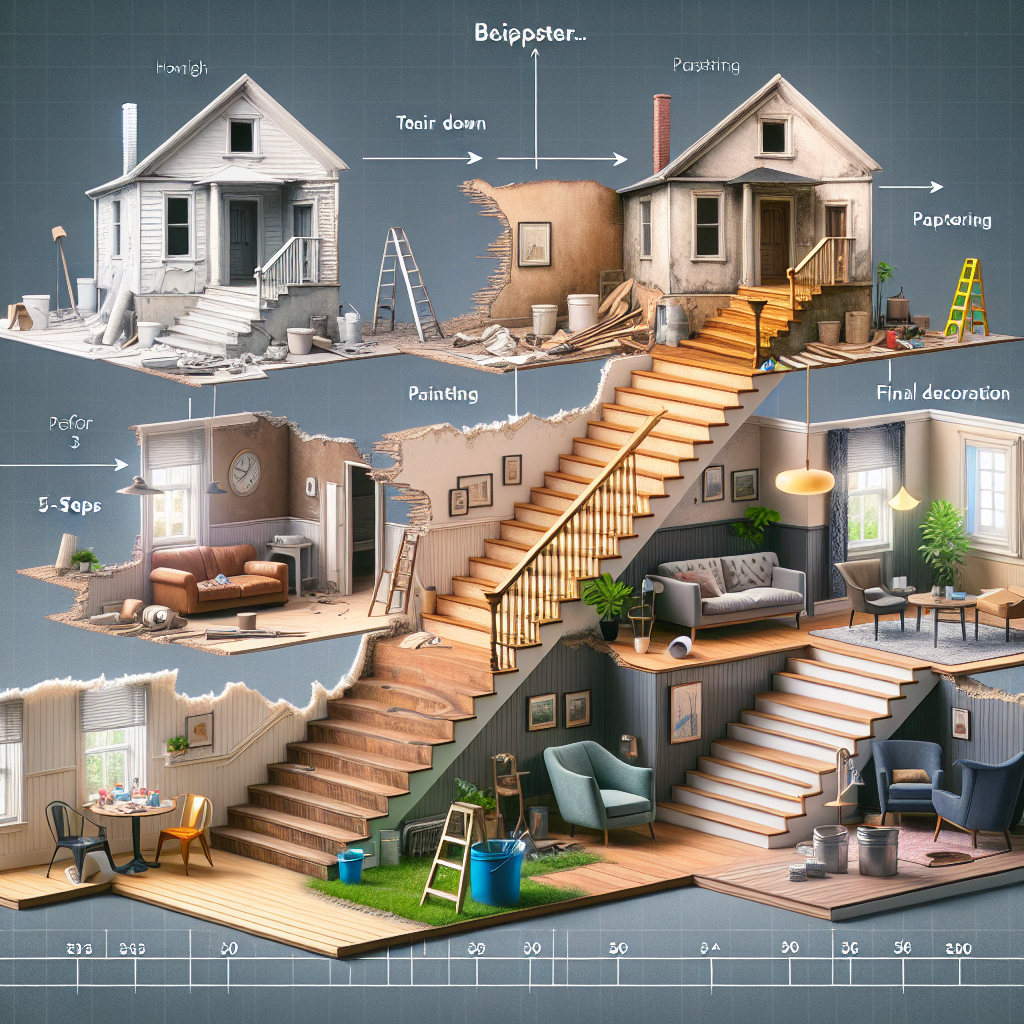1. Understanding Your Budget and Financing Options
Assessing Your Finances
Before diving into the world of fixer-uppers, the very first thing I recommend is to get a handle on your finances. Take a good look at your savings, income, and any debts you might have. This step is crucial because it sets the stage for what you can realistically afford, not just for the house but the renovations too.
I typically list all my sources of income and expenditure. That way, I can see how much I can allocate towards a mortgage each month. It’s key to remember that your budget isn’t just about the purchase price. You’ll need to consider the renovation costs, property taxes, insurance, and unexpected expenses.
Make sure you aren’t left high and dry post-purchase. The last thing you want is to stretch yourself too thin and struggle financially once you’ve moved in. A little planning goes a long way!
Finding the Right Financing
When it comes to financing a fixer-upper, you might find yourself overwhelmed with options. Traditional mortgages are a common route, but they might not cover renovation costs. I found that a good strategy is looking into renovation loans, such as FHA 203(k) loans. This type of loan allows you to roll the costs of the home and the projected renovations into one manageable monthly payment.
Additionally, don’t underestimate the power of local banks and credit unions. They can often offer competitive rates and personalized service, which could mean a big win for you in the long run. Personally, I built a friendly relationship with my bank, which led to some excellent advice and loan options that I wouldn’t have discovered alone.
Don’t forget to consider your credit score—this will play a big role in your financing options. The higher your score, the better terms you’ll likely get. A little bit of work to improve your credit can yield significant savings!
Setting a Realistic Renovation Budget
Once you’ve nailed down your financing, it’s time to set a realistic renovation budget. I suggest breaking this down into segments: what you want to upgrade immediately versus what can wait. For example, I prioritized essential repairs first—think roof leaks or plumbing issues—before moving on to cosmetic upgrades.
It’s also wise to leave a cushion in your budget for unforeseen circumstances. Trust me, you’ll likely encounter some surprises, especially in older homes, that can throw a wrench in your plans. I always add 10-20% to my renovation estimates just to be safe.
Finally, map out a timeline for your renovations. It helps to know which projects can be tackled simultaneously and which need to wait. Keeping a realistic time frame in mind will help maintain your enthusiasm through the renovation process!
2. Finding the Right Property
Researching Potential Neighborhoods
Choosing the right neighborhood is as important as the house itself. You want to find an area that not only suits your lifestyle but also has potential for growth. I spent hours researching neighborhoods, checking online forums, and even visiting during different times of day to get a feel for the community.
Look for neighborhoods that are in transition. These are areas where you can see signs of revitalization, such as new businesses or parks popping up. This is usually a sign that property values may rise, making your investment a smart one.
Moreover, think about the amenities that matter to you. Proximity to schools, parks, and public transit can significantly affect your quality of life and the resale value down the line. Take a stroll in the area and see how it feels—often, that gut feeling can guide you better than any statistic!
Inspecting Properties Thoroughly
Don’t rush the inspection process. This is your opportunity to uncover any hidden issues that could cost you later. The first property I considered had a charming exterior but a serious mold issue in the basement that would have hidden costs.
I always recommend hiring a professional inspector rather than relying on the seller’s disclosures. An inspector can spot structural issues, pest problems, and other costly repairs. Armed with this knowledge, you can negotiate a fair price or walk away if the issues are too severe.
Also, I learned the hard way to never underestimate the power of a second look. Revisit properties at different times or after certain repairs have been completed to gauge how it feels. This can save you from making a hasty decision!
Making an Offer
When the right property finally shows up, it’s time to make an offer. Understanding the market trends in your desired neighborhood can give you leverage here. I always do my homework on recent sales to best gauge an adequate offer.
Be ready to negotiate, and don’t be afraid to be assertive, especially if there are multiple offers on the table. I remember one instance where small repairs were highlighted during the inspection, giving me the confidence I needed to negotiate the price down.
Lastly, work with an experienced real estate agent to guide you through the complexities of the offer and closing process. Their insights can help protect you from potential pitfalls and get you the best deal.
3. Planning Your Renovation
Creating a Master Plan
Now that you have your fixer-upper, it’s time to create a master renovation plan. I can’t stress enough the importance of this step. It’s your roadmap for the transformation you envision. Take a whole-house approach and list everything you want to do, from major renovations to aesthetic changes.
I also recommend prioritizing your list. Factors like budget, necessity, and time frame should all be considered here. Once you know what’s most important, it will make it easier to allocate your resources effectively.
Don’t forget to seek inspiration! Pinterest and Instagram can be treasure troves for design ideas and practical solutions. I often saved color palettes and layout ideas that resonated with me, which made it easier to visualize my final outcome.
Hiring the Right Professionals
Depending on the complexity of your renovation, you might need to hire professionals. I learned this the hard way! While DIYing is fun and budget-friendly, some projects require a professional touch, especially those involving structural changes or electrical work.
Take your time researching potential contractors. Ask for recommendations and read reviews. Schedule interviews to determine who understands your vision the best. A good contractor will not only possess the right skills but also communicate well and respect your timeline.
Also, don’t hesitate to ask for quotes from multiple contractors. However, be wary of offers that seem too good to be true. Think of it as a balance between quality and cost; you want someone who can deliver what you envision without cutting corners.
Staying Organized Throughout the Process
Managing a renovation can quickly become overwhelming. Keeping files organized, maintaining schedules, and continuously communicating with your team will be your best friends throughout this process. I created a spreadsheet that highlighted project timelines, budgets, and contact information for everyone involved.

https://Credit411USA.com
Frequent check-ins are key. I made it a habit to meet with my contractor weekly, keeping tabs on the progress and addressing any issues that arose. This way, I didn’t feel blindsided by any surprises and kept the project moving forward.
Lastly, embrace flexibility. Delays and hiccups are a part of any renovation journey. Staying adaptable will help you maintain your sanity and enable you to navigate any unforeseen challenges with grace!
4. Designing Your Dream Space
Choosing a Style that Reflects You
With your renovation practically underway, it’s time to inject your personality into the space. I found the best approach is to choose a design style that reflects who you are. Whether it’s modern, rustic, or eclectic, ensure that your choices resonate with you.
Investigate design trends but don’t feel pressured to conform to them. I took the time to understand what really made me happy and what I could see myself living with in the long term. The spaces that inspire a sense of warmth and joy will undeniably be the ones that feel most like home.
Noticing color schemes and materials that appeal to you can help narrow down your choices as well—just remember that balance is vital. You can totally blend different styles, but maintaining harmony is key to achieving a cohesive look!
Incorporating Functional Space Design
Functionality is as important as aesthetics. Before making big design choices, I recommend considering how you and your family live within the space. For example, how many seats do you need at the dining table? Will you need workspace for remote work? You’ll want to create an environment that serves you.
I often sketch out layouts and furniture placements before finalizing any designs. This way, I can visualize how the flow works and make necessary adjustments. It’s crucial to ensure that the design enhances day-to-day living rather than complicating it.
Moreover, think about storage options. Adequate storage not only keeps your home clutter-free but also makes spaces feel larger and more organized. I incorporated built-in shelving and creative storage solutions to really maximize every nook and cranny in my fixer-upper!
Add Personal Touches
Now that the major design choices are in place, it’s time to add your personal flair! I believe that little details can make a world of difference. From family photos to unique art pieces, choosing decor that resonates with your story just brings everything together.
Certainly, don’t shy away from DIY projects to personalize your space. I had a lot of fun making my own artwork and decorative pieces that not only fit my style but also told a story. It not only elevates your space but also adds sentiment—you can’t put a price on that!
Most importantly, give yourself the freedom to change things up as time goes on. Develop a space that evolves with you and reflects different phases of your life. It’s your home—make it a place that tells your unique tale!
5. Maintaining Your Newly Renovated Home
Establishing a Maintenance Plan
Once you’ve transformed your fixer-upper into the dream home you’ve always wanted, it’s crucial to develop a maintenance routine. Trust me, neglecting maintenance can lead to problems down the line, so I emphasize regularly checking systems like heating, plumbing, and electrical setups.
Regular inspections can help you spot issues before they escalate. For example, checking the roof after heavy storms or inspecting for any signs of pests. Setting calendar reminders for maintenance tasks has been a handy way for me to stay on top of my home’s needs.
Don’t forget to keep up with seasonal tasks as well—like gutter cleaning and winterizing your home. Staying proactive saves you money and protects your renovations in the long run!
Regular Cleaning and Upkeep
Maintaining cleanliness has its merits. A clean home not only looks better but also prolongs the life of your features and systems. For my home, I developed a weekly cleaning schedule to keep things orderly, making the upkeep manageable and less daunting.
Also, consider investing in high-quality cleaning products and tools. They not only make the cleaning process a breeze but also help ensure your surfaces and materials last as long as possible.
If you’re like me, remember to schedule a little upkeep for your garden and outdoor areas too. Curb appeal matters, and keeping those outdoor spaces tidy enhances the overall charm of your property!
Embracing Future Improvements
Your home should evolve with you. After you’ve settled into your newly renovated space, don’t forget to embrace potential future improvements. There’s always room for small upgrades that can enhance your living experience, whether it’s adding energy-efficient appliances or updating bathroom fixtures.
Keep an eye out for local trends that may influence your home’s future value. I found that gradual updates based on evolving styles and technologies can maintain your home’s appeal and functionality.
Most importantly, enjoy your home! Celebrate your accomplishments and take pride in the hard work you put into transforming your fixer-upper. It’s now your haven, and it should reflect all the love and effort you poured into it!
FAQs
1. What is a fixer-upper?
A fixer-upper is a property that requires repairs or renovations. Often, these homes are priced lower than move-in-ready homes, making them an affordable choice for buyers who are willing to invest in improvements.
2. How do I find a good fixer-upper?
Research neighborhoods, check real estate listings, and attend open houses. Engage with local real estate agents who can guide you to potential properties that fit your criteria.
3. Should I do renovations myself or hire professionals?
It depends on your skill level. Basic cosmetic updates can be great DIY projects. However, for structural changes or complex work, hiring professionals is advisable to ensure safety and quality work.
4. How do I set a budget for renovations?
Assess your finances first, then research typical renovation costs. Break down your budget into categories like essential repairs, upgrades, and unexpected expenses to ensure you cover all bases.
5. How can I make my renovated home feel personal?
Add your own style through decor, artwork, and functional furnishings that reflect your life and experiences. DIY projects and personal artifacts can help create an inviting, unique atmosphere!

https://Credit411USA.com

